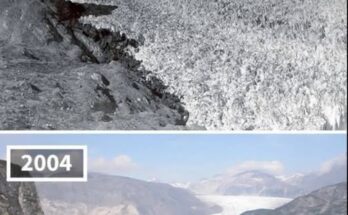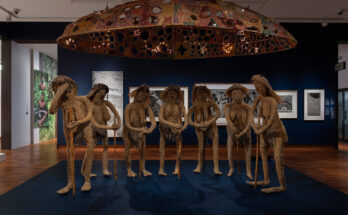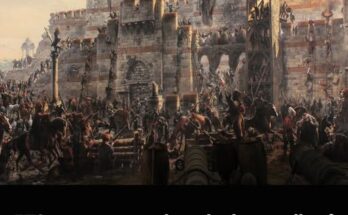What if the tranquil depths of a serene lake held not just fish and reeds, but the perfectly preserved secrets of a forgotten medieval warrior, undisturbed for nearly half a millennium? Such was the extraordinary discovery beneath Lake Asveja in Lithuania, where modern construction inadvertently unveiled a unique window into 16th-century life and death.
The remarkable find occurred in 2020, during underwater archaeological surveys conducted in preparation for the reconstruction of the wooden bridge in Dubingiai, a town renowned for its historical significance and a castle that once belonged to the Radziwill family. Approximately 30 feet below the surface, near the lakebed of Lake Asveja (also known as Dubingiai Lake), archaeologists from the Lithuanian Archaeology Institute encountered an astonishing sight: the remarkably well-preserved remains of a young man, seemingly lying as he fell centuries ago, along with his personal belongings.
The unique conditions of the lake’s environment—cold, low-oxygen waters, and a thick layer of silt—acted as a natural time capsule, protecting the organic materials from decay. This preservation was so exceptional that much of the warrior’s clothing, parts of his leather boots, and even two small wooden stakes that had been driven into the lakebed near his body remained intact. Alongside the remains, archaeologists recovered artifacts that immediately spoke of his status and the era: a pair of spurs, a sword, and two knives. These items were not merely grave goods; they were the tools and accoutrements of a man of war from the early modern period.
Preliminary analysis of the remains, including anthropological studies, suggested the individual was a young man, likely a knight or noble, given the quality of his gear. The presence of the wooden stakes has led to various theories, including the possibility of an accident, a battle, or even a deliberate, perhaps ritualistic, burial in the lake. While his exact identity and the circumstances of his death remain a subject of ongoing research, this extraordinary underwater archaeological site provides an unprecedented glimpse into Lithuania’s martial past. It offers invaluable insights not only into the material culture and weaponry of the 16th century but also into the burial practices and daily life of individuals in that tumultuous era, all preserved just beneath the placid surface of one of Lithuania’s ancient lakes.

There is something paradoxical about still water. It appears calm, timeless, immune to the chaos of history. Yet sometimes, beneath that placid surface, lies a vault of forgotten stories. In 2020, the gentle waves of Lake Asveja in Lithuania—silent for centuries—parted momentarily to reveal one of the most astonishing archaeological discoveries in recent European history: the fully clothed and remarkably preserved body of a young medieval warrior, untouched by time for nearly 500 years.
This discovery not only captivated the archaeological community but also ignited a collective curiosity about a period of Lithuanian history often overshadowed by broader European narratives. More than just a skeleton, this warrior carried with him artifacts, clues, and questions—about warfare, identity, ritual, and memory. His final resting place, submerged and secluded, became an unexpected window into the past.
Chapter I: A Quiet Lake with a Storied Past
Lake Asveja, sometimes referred to by its historical name Dubingiai Lake, is Lithuania’s longest lake, stretching over 21 kilometers through a region of thick forests, low hills, and scattered rural communities. It is nestled near the town of Dubingiai, a historically important location due to its connections with one of Lithuania’s most influential noble families—the Radziwiłłs (Radvila in Lithuanian).
In the 16th and 17th centuries, Dubingiai was a stronghold of Protestantism and political intrigue, a center of reform and resistance during the Reformation and Counter-Reformation. The nearby Dubingiai Castle, though now a ruin, once stood as a proud fortress of Renaissance ambition. Its inhabitants were not only nobles but patrons of education, military strategy, and political power. This makes the lake’s discovery all the more poignant—suggesting that the man beneath the waves may have played a role in the great historical dramas of his age.
Chapter II: A Discovery by Accident
The 2020 find was unexpected. The Lithuanian Road Administration had commissioned archaeological surveys in preparation for the reconstruction of a wooden bridge over the lake. These surveys, routine in nature, involved a dive team from the Lithuanian Institute of History and the Klaipėda University Underwater Archaeology department.
Roughly nine meters beneath the surface, in the muddy sediment of the lakebed, divers saw something unexpected: not just artifacts, but a human form. Unlike many submerged archaeological finds, this one was not fragmented, scattered, or stripped by time. The skeleton lay in a strikingly natural position, as if resting, preserved by the cold, low-oxygen water and blanketed by centuries of undisturbed silt.
To the astonishment of the archaeologists, much of the individual’s clothing remained intact. The boots, made of leather, were still on his feet. His sword lay beside him. Spurs clung to his heels. Nearby, two wooden stakes jutted from the lakebed, their purpose unclear but certainly deliberate.
Chapter III: The Man in the Lake
Preliminary analysis revealed that the body belonged to a young adult male, probably in his early twenties. Though DNA testing is ongoing and full identification may never be possible, certain deductions have already been made. He was strong, robust, and in good health—typical of a military man or someone raised for combat. His skeleton bore no immediate signs of major trauma, but his death was clearly sudden. The absence of a coffin or grave goods (in the traditional sense) raised questions about the nature of his burial.
The artifacts discovered with the body—spurs, a sword, and two knives—suggested not only martial status but a level of wealth or nobility. Spurs were a marker of cavalrymen or knights, worn with pride as symbols of class and function. The sword, while not ornamented with excessive luxury, was a finely crafted weapon—functional, durable, deadly.
The presence of the wooden stakes near the body puzzled researchers. Were they markers? Anchors? Part of a hastily built underwater burial ritual? Or could they represent something darker, perhaps even punitive?
Chapter IV: Dogfights and Diplomacy – Lithuania in the 16th Century
To understand this man’s life and death, we must step back into the political and military climate of Lithuania in the 16th century. This was an era of turmoil and transformation. The Grand Duchy of Lithuania, once the largest country in Europe, had by the mid-1500s entered a dynastic union with Poland, creating the Polish-Lithuanian Commonwealth. This powerful state was a melting pot of cultures, religions, and ambitions—but it was far from peaceful.
Noble families like the Radziwiłłs frequently clashed over religion, territory, and influence. There were skirmishes with the Teutonic Knights, tensions with Muscovy, and feuds among Lithuanian aristocrats. A young nobleman could easily find himself drawn into a localized conflict, a personal vendetta, or a cross-border battle.
Given Dubingiai’s importance as a Radziwiłł stronghold, it is entirely plausible that the warrior beneath Lake Asveja had a direct connection to one of these episodes of strife. He may have been on patrol, ambushed, or fleeing. He may have drowned in a skirmish or died of wounds received elsewhere before being deposited in the lake.
Chapter V: Not a Traditional Burial
What makes this discovery exceptional is the burial context—or the lack thereof. Medieval and early modern European burials followed distinct conventions, especially for Christians. Burials were typically in cemeteries, near churches, in marked graves. Even soldiers who died in war were buried in mass graves or honored with rites if possible.
This warrior was not buried but abandoned—or concealed—beneath the water. Was he given a secret ritual burial, one outside Church sanction? Or was his death the result of a hurried cover-up? The spurs and sword suggest he was not a common criminal. But if he had been a political enemy or victim of foul play, his disposal in a lake might have been a symbolic erasure.
Alternatively, some archaeologists have posited that he may have fallen through the ice or drowned during combat and was never recovered. Yet the wooden stakes remain anomalous—deliberate signs that someone knew where he lay.
Chapter VI: Water and Memory in Baltic Folklore
Water has long played a symbolic role in Baltic and pagan folklore, even into Christian times. Lakes, rivers, and springs were believed to house spirits or act as gateways to other worlds. In some traditions, offerings were made to lakes in the form of swords or personal belongings.
This spiritual significance may lend another layer of meaning to the underwater burial. Was it ritualistic? Punitive? Protective? The duality of water as both a source of life and a hiding place of death resonates with how the body remained so eerily untouched, as if the lake chose to preserve the story.
Chapter VII: A Time Capsule of Daily Life
While much attention has rightly been focused on the mystery of his death, the preservation of clothing and personal items offers rare insight into everyday material culture. Unlike grave finds, where clothing may be curated for symbolism, the man in Lake Asveja wore what he had on in life.
The leather boots, still intact, show signs of wear but are remarkably well-made, indicating his status. The sword was not a ceremonial weapon but one balanced for real combat. The knives suggest utilitarian use as well as defense.
By studying the stitching, materials, and metallurgy, researchers can reconstruct trade routes, social class, and even tailoring techniques of the time. His body becomes a museum of 16th-century life—not in a palace or church, but as lived and lost by one anonymous soul.
Chapter VIII: Technology and Preservation
Modern technology played a key role in the successful recovery and analysis of the body. Advanced underwater imaging, photogrammetry, and 3D scanning allowed researchers to document the site in detail before removal. CT scans of the bones revealed no immediate fractures but did show signs of robust physical activity, perhaps even repetitive riding.
Preservation techniques now being employed include freeze-drying organic materials, careful chemical treatments, and digital archiving. The find has been hailed as one of the best-preserved examples of underwater human remains from this period in Europe, and it may set a precedent for future lake-based excavations.
Chapter IX: A Life Reconstructed
Although we may never know his name, age, or precise allegiance, the Asveja warrior is gradually taking shape. He was likely of noble birth or knightly station, possibly connected to the Radziwiłłs or another powerful family. His gear marks him as a trained fighter. His death was sudden, perhaps tragic, perhaps violent, and his interment unconventional.
Yet he was not entirely forgotten. The lake held him in its cold cradle, untouched by time, until the modern world rediscovered him. His presence forces us to reevaluate assumptions about warfare, burial, and identity in early modern Lithuania.
Conclusion: The Echoes of a Silent Warrior
The Asveja warrior’s story resonates because it is both unique and universal. Unique in its preservation, in its archaeological significance, in its rich context. But universal in its humanity: a young man lost in conflict, remembered not by name but by the traces he left behind.
History often focuses on kings, treaties, and revolutions. But occasionally, a forgotten individual rises—literally—from the depths, reminding us that history is made not only by the powerful, but also by the brave, the unfortunate, and the anonymous.
As research continues, the Asveja warrior will inspire not only archaeologists, but poets, artists, and thinkers who see in him a symbol of Europe’s buried past—resurfacing not to haunt, but to teach, to witness, and to speak.


